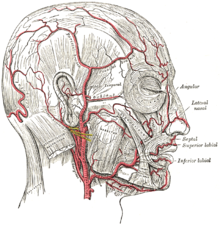Facial artery
The arteria facialis ("facial artery ") is the artery that supplies most of the superficial structures of the face in humans and mammals . Only sheep and goats do not have an arteria facialis, here the arteria transversa faciei takes care of the face, but the corresponding vein , vena facialis , is also developed in these animals.
The Arteria Facialis arises as the third main trunk from the external carotid artery ( Arteria carotis externa ), in horses and cattle together with the Arteria lingualis as Truncus linguofacialis , which soon divides into the two individual vessels. The facial artery runs under the stylohyoid and digastric muscles and passes the lower jaw bone ( mandible ) at the front edge of the masseter muscle , where it lies in a notch in the bone ( incisura vasorum facialium ). You can also easily feel your pulse here. After that it lies under the platysma and gradually branches into its terminal branches.
branch
- Arteria sublingualis (" sublingual artery "), arises in humans and in ruminants from the arteria lingualis
- Arteria palatina ascendens (" ascending palatal artery") to supply the throat
- Submental artery ("sub chin artery"), whichsuppliesthe mandibular salivary glandsand adjacent structures
- Inferior labial artery ( "lower lip artery") to the lower lip
- Arteria labialis superior ("upper lip artery ") to the upper lip
- Arteria angularis ("(ocular) angular artery") to the nose and the inner corner of the eye
In horses, the facial artery also discharges the lateral nasal artery ( arteria lateralis nasi ) and the nasal dorsal artery ( arteria dorsalis nasi ).
Individual evidence
- ↑ FCAT - Federative Committee on Anatomical Terminology: Terminologia Anatomica. Thieme, Stuttgart et al. 1998, ISBN 3-13-114361-4 .
literature
- Theodor H. Schiebler (Ed.): Anatomie. Histology, history of development, macroscopic and microscopic anatomy, topography. Taking into account the item catalog. 9th, completely revised edition. Springer, Heidelberg 2005, ISBN 3-540-21966-8 .
- Uwe Gille: Cardiovascular and immune system, Angiologia. In: Franz-Viktor Salomon, Hans Geyer, Uwe Gille (Ed.): Anatomy for veterinary medicine. 2nd, revised and expanded edition. Enke, Stuttgart 2008, ISBN 978-3-8304-1075-1 , pp. 404-463.

